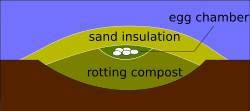- Megapode
-
For other uses of the term "mound builder", see Mound builder (disambiguation).
Megapodiidae 
Australian Brushturkey (Alectura lathami) Scientific classification Kingdom: Animalia Phylum: Chordata Class: Aves Order: Galliformes Family: Megapodiidae
Lesson, 1831Genera - Eulipoa
- Megapodius
- Macrocephalon
- Leipoa
- Talegalla
- Aepypodius
- Alectura
The megapodes, also known as incubator birds or mound-builders, are stocky, medium-large chicken-like birds with small heads and large feet in the family Megapodiidae. Their name literally means large foot (Greek: mega = large, poda = foot), and is a reference to the heavy legs and feet typical of these terrestrial birds. All are browsers, all but the Malleefowl occupy wooded habitats, and most are brown or black colored. Megapodes are superprecocial, hatching from their eggs in the most mature condition of any birds. They hatch with open eyes, with bodily coordination and strength, with full wing feathers and downy body feathers, able to run, pursue prey, and, in some species, fly on the same day they hatch.[1]
Contents
Breeding and nests
 Cross section of a Megapode mound, showing layer of sand (up to 1 m thick) used for insulation; egg chamber; and layer of rotting compost. The egg chamber is kept at a constant 33°C by opening and closing air vents in the insulation layer, while heat comes from the compost below.
Cross section of a Megapode mound, showing layer of sand (up to 1 m thick) used for insulation; egg chamber; and layer of rotting compost. The egg chamber is kept at a constant 33°C by opening and closing air vents in the insulation layer, while heat comes from the compost below.
Megapodes do not incubate their eggs with their body heat as other birds do, but bury them. Their eggs are unique in having a large yolk, making up 50-70% of the egg weight.[2] They are best known for building massive nest-mounds of decaying vegetation, which the male attends, adding or removing litter to regulate the internal heat while the eggs hatch. However, some bury their eggs in other ways: there are burrow-nesters which use geothermal heat, and others which simply rely on the heat of the sun warming sand. Some species vary their incubation strategy depending on the local environment.[3] Although the Australian Brushturkey is the only species of bird in which sex ratio is confirmed to be incubation-temperature dependent, it is speculated that this is common to all Megapodes, as they share nesting methods unique among birds.[4] The non-social nature of their incubation raises questions as to how the hatchlings come to recognise other members of their species, which is due to imprinting in other members of the order Galliformes. Recent research suggests that there is an instinctive visual recognition of specific movement patterns made by the individual species of megapode.[5]
Many are shy, solitary, and inconspicuous.
Megapode chicks do not have an egg tooth: they use their powerful claws to break out of the egg, and then tunnel their way up to the surface of the mound, lying on their backs and scratching at the sand and vegetable matter. Similar to other superprecocial birds, they hatch fully feathered and active, already able to fly and live independently from their parents.[2]
Distribution
Megapodes are found in the broader Australasian region, including islands in the western Pacific, Australia, New Guinea, and the islands of Indonesia east of the Wallace Line, but also the Andaman and Nicobar Islands in the Bay of Bengal. The distribution of the family has contracted in the Pacific with the arrival of humans, and a number of island groups such as Fiji, Tonga and New Caledonia have lost many or all of their species.[3]
Species
There are more than 20 species in 7 genera. Although the evolutionary relationships between the Megapodiidae are especially uncertain[citation needed], the morphological groups are clear:[6]
FAMILY: MEGAPODIIDAE
- Scrubfowl group
- Genus: Macrocephalon
- Maleo, Macrocephalon maleo
- Genus: Eulipoa (sometimes included in Megapodius)
- Moluccan Megapode, Eulipoa wallacei.
- Genus: Megapodius
- Tongan Megapode, Megapodius pritchardii
- Micronesian Megapode, Megapodius laperouse
- Marianas Island Megapode, Megapodius laperouse laperouse
- Palau Island Megapode, Megapodius laperouse senex
- Nicobar Megapode, Megapodius nicobariensis
- Philippine Megapode, Megapodius cumingii
- Sula Megapode, Megapodius bernsteinii
- Tanimbar Megapode Megapodius tenimberensis
- Dusky Megapode, Megapodius freycinet
- Forsten's Megapode, Megapodius (freycinet) forstenii
- Biak Scrubfowl Megapodius geelvinkianus
- Melanesian Megapode, Megapodius eremita
- Vanuatu Megapode, Megapodius layardi
- New Guinea Scrubfowl, Megapodius affinis
- Orange-footed Scrubfowl Megapodius reinwardt
- †Pile-builder Scrubfowl Megapodius molistructor
- Genus: Macrocephalon
- Malleefowl group
- Genus: Leipoa
- Malleefowl, Leipoa ocellata
- Genus: Leipoa
- Brushturkey group
- Genus: Alectura
- Australian Brushturkey, Alectura lathami
- Genus: Aepypodius
- Wattled Brushturkey, Aepypodius arfakianus
- Waigeo Brushturkey, Aepypodius bruijnii
- Genus: Talegalla
- Red-billed Brushturkey, Talegalla cuvieri
- Black-billed Brushturkey, Talegalla fuscirostris
- Collared Brushturkey, Talegalla jobiensis
- Genus: Alectura
References
- ^ Starck, J.M., Ricklefs, R.E.(1998) "Avian Growth and Development. Evolution within the altricial precocial spectrum." Oxford University Press, New York, 1998.
- ^ a b Starck, JM & SUtter E (2000) Patterns of growth and heterochrony in moundbuilders (MEgapodiidae) and fowl (Phasianidae). J. Avian Biol. 31:527-547
- ^ a b Steadman D, (2006). Extinction and Biogeography in Tropical Pacific Birds, University of Chicago Press. ISBN 978-0-226-77142-7
- ^ Göth, A. & D.T. Booth. (2005) "Temperature-dependent sex ratio in a bird." Biol. Lett. 1(1):31-3.
- ^ Göth, A., & Evans, C. S. (2004). Social responses without early experience: Australian brush-turkey chicks use specific visual cues to aggregate with conspecifics. Journal of Experimental Biology, 207, 2199-2208. doi:10.1242/jeb.01008
- ^ Birks, S. M., and S. V. Edwards. 2002. A phylogeny of the megapodes (Aves: Megapodiidae) based on nuclear and mitochondrial DNA sequences. Molecular Phylogenetics and Evolution 23: 408-421.
External links
- Mound-builders videos, photos & sounds on the Internet Bird Collection
- Photograph of a nest mound of M. tenimberensis from the Oriental Bird Club
Categories:- Megapodiidae
- Bird families
Wikimedia Foundation. 2010.


